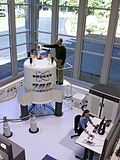Nuclear magnetic resonance
Nuclear magnetic resonance (NMR) is the physical phenomenon in which magnetic nuclei in a magnetic field absorb, then re-emit electromagnetic radiation. This energy is of a specific resonance frequency that depends on the magnetic field strength, and the magnetic properties of the isotopes of the atoms. Many scientific techniques use it to study molecular physics, crystals and non crystalline materials through NMR spectroscopy. NMR is also used for advanced medical imaging techniques, for example, magnetic resonance imaging (MRI).
How it works
All isotopes that contain an odd number of protons and/or of neutrons (see Isotope) have an intrinsic magnetic moment and angular momentum, in other words a nonzero spin, while all nuclides with even numbers of both have a total spin of zero. The most commonly studied nuclei are 1H and 13C, although nuclei from isotopes of many other elements (e.g. 2H, 6Li, 10B, 11B, 14N, 15N, 17O, 19F, 23Na, 29Si, 31P, 35Cl, 113Cd, 129Xe, 195Pt) have been studied by high-field NMR spectroscopy as well.
A key idea of NMR is that the resonance frequency of a particular substance is directly proportional to the strength of the applied magnetic field. This resonance is used in imaging techniques. If a sample is placed in a non-uniform magnetic field then the resonance frequencies of the sample's nuclei depend on where in the field they are located. Scientists try to use the highest possible magnetic fields to get the best image quality.
The principle of NMR usually involves two sequential steps:
- The alignment (polarization) of the magnetic nuclear spins in an applied, constant magnetic field H0.
- An electro-magnetic, usually radio frequency (RF), pulse causes a small shift of this alignment of the nuclear spins. The pulse frequency is chosen based on the static magnetic field (H0) and the nuclei being measured.
The constant field and the pulse field are usually set perpendicular to each other. This maximizes the NMR signal strength. The resulting response by the total magnetization (M) of the nuclear spins is what is used in NMR spectroscopy and magnetic resonance imaging. Both use intense applied magnetic fields (H0) in order to achieve dispersion and very high stability to deliver spectral resolution. Scientist explain their readings as chemical shifts, the Zeeman effect, and Knight shifts (in metals).
NMR is used in low-field NMR, NMR spectroscopy and MRI in the Earth's magnetic field (referred to as Earth's field NMR), and in several types of magnetometers.
History
Nuclear magnetic resonance was first described and measured in molecular beams by Isidor Rabi in 1938.[1] In 1944, Rabi was awarded the Nobel Prize in Physics for this work.[2] In 1946, Felix Bloch and Edward Mills Purcell expanded the technique for use on liquids and solids. They shared the Nobel Prize in Physics in 1952 for this discovery.[3][4]
Purcell had worked on the development of radar during World War II at the Massachusetts Institute of Technology's Radiation Laboratory. His work during that project on the production and detection of radio frequency power and on the absorption of such RF power by matter laid the background for Rabi's discovery of NMR.
Rabi, Bloch, and Purcell noticed that magnetic nuclei, like 1H and 31P, could absorb RF energy when placed in a magnetic field of a strength specific to the identity of the nuclei. When this absorption occurs, the nucleus is described as being in resonance. Different atomic nuclei within a molecule resonate at different (radio) frequencies for the same magnetic field strength. The observation of such magnetic resonance frequencies of the nuclei present in a molecule allows any trained user to discover essential, chemical and structural information about the molecule.
After World War II, the development of NMR as a technique in analytical chemistry and biochemistry happened at the same time as the development of electromagnetic technology and advanced electronics and their introduction into civilian use. In the 1960s, William Lipscomb was a pioneer in using NMR to study chemical structures. He worked out how to look at NMR data to tell what atoms are connected together in a molecule. This is called chemical shift.[5]
Nuclear Magnetic Resonance Media
References
- ↑
I.I. Rabi, J.R. Zacharias, S. Millman, P. Kusch (1938). "A New Method of Measuring Nuclear Magnetic Moment". Physical Review. 53 (4): 318–327. Bibcode:1938PhRv...53..318R. doi:10.1103/PhysRev.53.318. PMID 9981980.
{{cite journal}}: CS1 maint: multiple names: authors list (link) - ↑ Biography of I. Rabi at Nobelprize.org
- ↑ Filler, Aaron (2009). "The History, Development and Impact of Computed Imaging in Neurological Diagnosis and Neurosurgery: CT, MRI, and DTI". Nature Precedings. doi:10.1038/npre.2009.3267.4.
- ↑ 1952 Nobel Prize for Physics at Nobelprize.org
- ↑ Lipscomb WN, The chemical shift and other second-order magnetic and electric properties of small molecules. Advances in Nuclear Magnetic Resonance. Edited by J. Waugh, Vol. 2 (Academic Press, 1966), pp. 137-176





